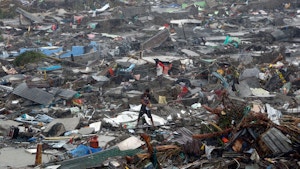More needs to be done to prevent further deforestation within the Philippines. The country, which hosts two-thirds of the planet’s biodiversity and up to four-fifths of its flora and fauna, is fighting an uphill battle to preserve its wildlife. The nation is currently losing an estimated 47,000 hectares of rainforest every year and has lost around 60 per cent of its forest cover in the last 80 years.
While the Philippines is an agricultural country with a land area of around 30 million hectares, only around 24.1 per cent of its land area remained forested as of 2020.
The country is affected by an average of 20 major storms a year as it sits within the typhoon belt, an area in the western Pacific Ocean where nearly one-third of the world’s tropical cyclones form. This, combined with current deforestation rates, has resulted in soil erosion, landslides, flash floods, food and water insecurity, and an insecure water supply, and has led to the displacement of indigenous tribes.
In 2019, the Philippines’ Department of Environment and Natural Resources (DENR) classified 55 mammals, 184 birds, 53 reptiles, 30 amphibians, and 784 invertebrates as threatened species.
“If the forests in which these species reside are cleared, their only habitat, including their food sources and environment needed to reproduce, will be destroyed,” Anna Varona, chief operating officer of the Haribon Foundation for the Conservation of Natural Resources, told Eco-Business. “Consequently, there is a high probability that these unique species may vanish or become extinct.”
Sources of destruction
Much of the country’s forest loss stemmed from indiscriminate logging operations from 1935 to 1991. Agricultural expansion, mining, urbanisation, and forest conversion into resorts, roads, and dams have also contributed to forest loss over the years, Varona noted.
Climate-induced extreme weather events, such as Typhoon Haiyan – which not only took more than 6,000 lives but also decimated 86 per cent of the mangrove forests in eastern Philippines in 2013 – are also exacerbating forest degradation.
Meanwhile, the country’s burgeoning population of more than 110 million people has led to an increased demand for goods and services from forest ecosystems.
“With a growing population there is increasing pressure from different clients and customers within the forestry sector to meet all or most of the domestic needs for wood, fuelwood, major and minor forest products, and other forest ecosystem-related goods and services,” according to the Philippine Master Plan for Climate Resilient Forestry Development.
The plan, formulated in 1990, came after a government ban on log and lumber exports a year prior to striking a better balance between the development of forest-based industries and the conservation of forest ecosystems. The policy was updated in 2003 when major programmes failed and revamped again in 2013 to factor in the impact of climate change on forestry.
Preservation efforts
In 2011, two major forest management-related policy changes were issued. One was a moratorium on the cutting and harvesting of trees in natural forests and the establishment of an Anti-Illegal Logging Task Force.
The second was the National Greening Program (NGP), a campaign to plant 1.5 billion trees on 1.5 million hectares between 2011 and 2016. This was later extended to 2028, with coverage expanded to include 7.1 million hectares of unproductive, denuded and degraded forests. Around 1.83 billion seedlings have been planted on 2.18 million hectares of land through the NGP as of 2022.
The interventions have led to modest gains: data from the Food and Agriculture Organization show that the Philippines recorded a 0.5 per cent increase in forest cover between 2010 and 2020. On average, 34,900 hectares of forest cover were added each year.
Despite the reported increase in forest cover, Varona cautioned that the planting of exotic trees “does not promote Philippine biodiversity.”
“I believe the focus should be on native tree species that support the country’s unique ecosystem. By prioritising indigenous trees and considering their ecological significance, reforestation efforts can better preserve and restore the country’s rich biodiversity while addressing deforestation concerns,” she said.

A volunteer at Energy Development Corporation’s BINHI programme inspecting the trees at a forest located in Ilocos Norte, a province in the northern Philippines. Image: Energy Development Corporation.
Sowing seeds; growing trees
The need to preserve indigenous trees is driving other reforestation efforts in the Philippines such as BINHI, the greening project of Energy Development Corporation (EDC), the world’s largest vertically integrated geothermal power producer in the world. Geothermal power, which is harnessed from heat inside the earth, is considered a renewable and sustainable source of energy. EDC is owned by First Gen Corporation, also a Philippines-based independent power producer.
With 47 per cent of the country’s indigenous trees threatened with extinction, BINHI, a Tagalog term for “seedling,” was established in 2008 to rescue, preserve and propagate native species.
The programme also conducts tree population surveys to determine their numbers and partners with stakeholders to protect forests. To date, the project has assessed and updated the conservation status of 1,470 tree species through the Botanic Garden Conservation International (BGCI) for the Global Tree Assessment, an initiative to conduct research and compile extinction risk information on all tree species worldwide, of which EDC BINHI is the sole Philippine partner. Of these, EDC has identified a total of 145 as priority species.
The survey helps the team to identify which tree species to focus on reforesting and also sheds light on species that were believed to be disappearing. For example, tree species such as the red lauan (Shorea negrosensis), a large evergreen tree that had only been found in Negros in the Visayas, and a plant species endemic to the Philippines locally referred to as Mapilig (Xanthostemon bracteatus), which had only been found in Camarines Norte in Luzon, were discovered in several other places around the country.
The team also identified dwindling tree varieties, including one species of tropical hardwood tree known locally as kaladis narig (Vatica elliptica). “We only found two trees standing in 2016. But through our partnership with the Provincial Government of Zamboanga Sibugay and the DENR, we found a total of 11 trees, which had already borne fruit during the COVID-19 pandemic,” said Roniño Gibe, EDC’s BINHI program head.
BINHI also plants trees outside their natural habitat for the purpose of nurturing them into mother trees that will produce viable seeds in the coming years. It plans to begin in-situ conservation this year, where species are planted in their natural habitats.
While it will be several years before the Philippines undoes the damage its forests have sustained, reforestation efforts are hoping to protect and preserve what is left and find new ways of repopulating barren areas.
As a result of the BINHI’s initiatives, 10 of the 145 species that were previously on EDC’s priority list have been removed, while 21 were downgraded from their “critically endangered” classification, according to Gibe.
Allan Barcena, assistant vice president and head of Corporate Relations and Communications at EDC, said the programme, which marks its 15th anniversary this year, will require the help of local communities and governments to continue flourishing.
This, Barcena concluded, will also ensure that EDC is able to continue its operations as a renewable energy producer.
“Few understand that there are tree species on the brink of extinction. We are happy that the local governments are beginning to realise that we have this heritage, and a part of our history, to protect,” he said. “To ensure that the business is sustainable, we need to restore the forests and partner with the communities within them.”
The Energy Development Corporation is hosting the Biodiversity Conservation Society of the Philippines in its 31st Annual Philippine Biodiversity Symposium on 22-25 August 2023 in Sorsogon City. Click here to register for the event.















